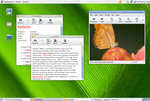| Windows | Linux | |||
|---|---|---|---|---|
| Graphical user interface |  The Windows Shell on Windows Vista The Windows Shell. This uses as its window manager the Desktop Window Manager on Windows Vista, and a Stacking window manager built on top of GDI in older versions. The desktop environment may be modified by a variety of third party products such as WindowBlinds; or completely replaced, for example by Blackbox for Windows, or LiteStep. |  The GNOME Desktop Environment A number of desktop environments are available, of which GNOME and KDE are the most widely used. By default, they use as their window managers Metacity and KWin respectively, though these can be replaced by other window managers such as Compiz Fusion. Other desktop environments and window managers include Enlightenment, Xfce, Openbox, Fluxbox, etc. See Also: Comparison of X Window System desktop environments. | ||
| Text user interface |  A sample Windows PowerShell session The Command Prompt exists for power users. The command line can be used to recover the system if the graphics subsystem fails. A .NET-based command line environment called Windows PowerShell has been developed. Its functionality is similar to that provided in Unix-like operating systems. Cygwin provides a UNIX-like terminal for Windows. Windows Script Host is included in Windows 98 and newer versions. |  A sample Bash session Linux is strongly integrated with the system console. Many applications can be scripted through the shell,[17] there are a lot of small and specialized utilities meant to work together and to integrate with other programs. This is called the toolbox principle. The command line can be used to recover the system if the graphics subsystem fails.[18][19] |
REFER WWW.WIKIPEDIA.COM

0 comments:
Post a Comment